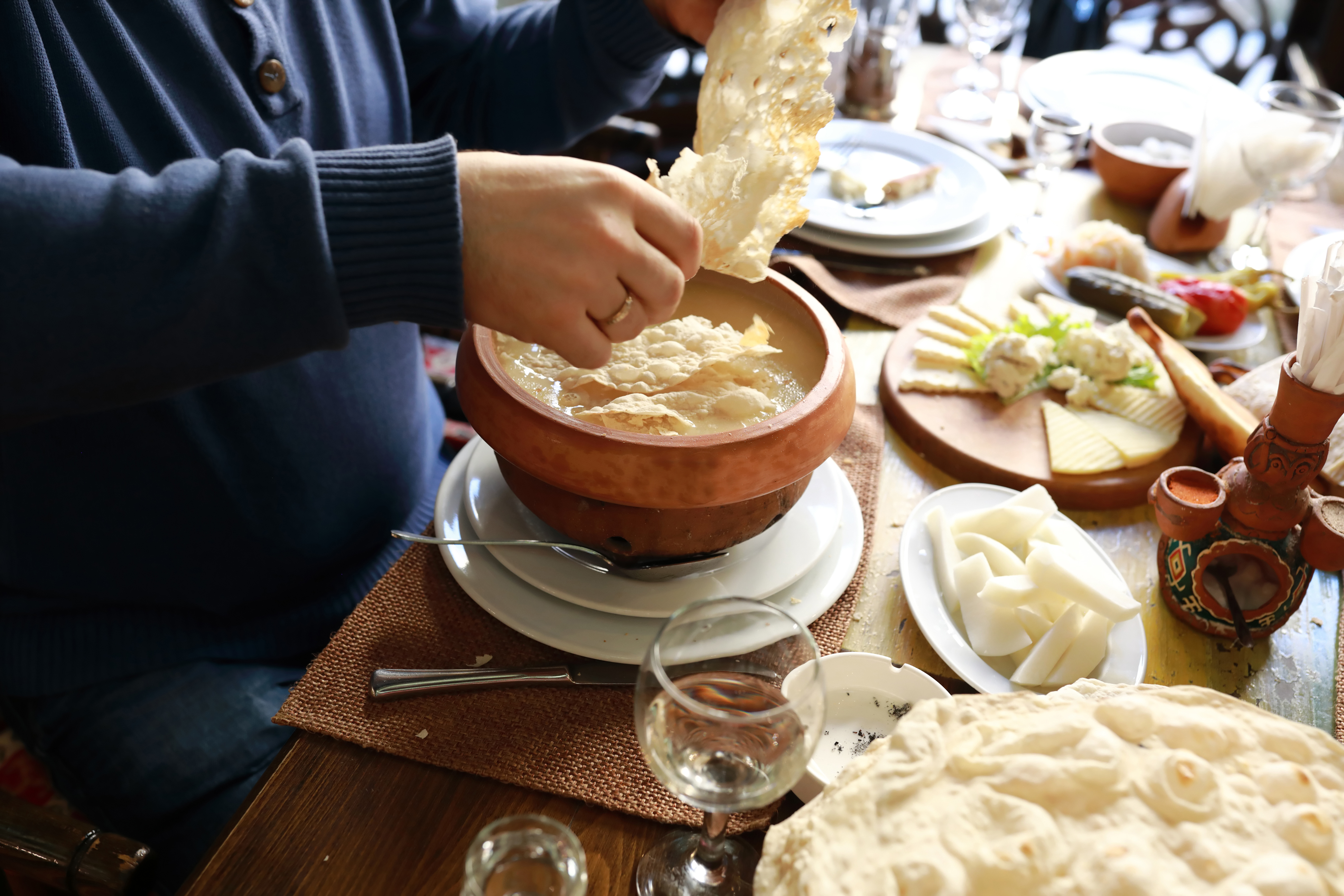
Published 8th Nov. 2022
Reading time
Travel enthusiasts and foodies often go hand in hand because what better way to discover a new far-flung place than through its culinary traditions? But even the bravest of food lovers can find an unknown dish a little intimidating. New textures and flavours can leave some of the most adventurous of eaters veering away from unusual foods in favour of something more universally palatable. But what happens when we step outside the foodie comfort zone and into the culinary world of the weird and wonderful? We might just find a newfound love and appreciation for a holiday destination or a new go-to recipe to cook for family and friends (maybe). To kickstart your journey into the unusual foods found around the world we’ve comprised a list of ten to keep in mind and try when travelling, if you’re brave enough to...
1
Nestled away from the well-loved cerulean seas lie the towering mountains surrounding the sleepy town of Nuoro, Sardinia. It’s home to ancient traditions and secretive grandmothers, waking at dawn to make the world's rarest pasta. Only one remaining family knows the 300-year-old recipe for Su filindeu, which means “the thread of the gods” in the Sardinian language. While it remains a tightly guarded secret, it’s said that the process begins by folding semolina dough into 256 perfectly even strands of pasta before crisscrossing diagonally on a circular frame to form the intricate three-layer pattern. It’s then added to a hearty boiled sheep’s broth and dusted in grated pecorino to form a thick soup, to be enjoyed by a select few. Since this method has proven so labour-intensive and time-consuming only those willing to complete the 22-mile pilgrimage (on foot or on horseback) from Nuoro to the quiet village of Lula for their biannual Feast of San Francesco can savour the fruits of these secretive cooks' labours.
2
The beating heart of South America, big beautiful and diverse Brazil has a penchant for another type of heart. It’s one called Coração de Frango (plant-based dieters we suggest you keep scrolling). This chicken heart delicacy has been consumed by Brazilians more than 5 billion times last year, confirming that unusual foods are on the increase. The poultry tickers have become such a firm favourite and domestic consumption is so high that it's now the only part of the chicken that the national poultry industry won't export. The simple prepping process of salt seasoning and grilling until ready, has seen the heart of the chicken skewered, added as a pizza topping, tossed with toasted cassava flour (farofa) and even stacked in a burger. It has a notably sweeter (albeit chewie) taste and is considered a great source of protein, iron, zinc, selenium and vitamin D, but would you have the heart to eat it?
3
Up next, we’re diving into one of Japan’s favourite traditional and unusual foods: shiokara. The dish is concocted using seafood that’s been fermented in its own viscera (found in the liver or intestines) before adding salt and some more fleshy tissue for good measure. Chefs can use a whole host of seafood treats to make variations of this dish, with the most common being ika no shiokara. This is made from small squids found off Japan’s coastlines, but Shiokara can also be made from shuto (tuna), ganzuke (crab), mefun (salmon) and uruka (sweetfish). It’s then seasoned to taste, adding everything from shichimi pepper and wasabi to mirin or grated yuzu peel. Some keep it simple and let the fish and addition of salt do the talking, but it’s certainly one for the fish lovers and more adventurous palates.
4
Found below the flora and fauna rich vegetation of São Miguel of the Azores islands lies a hearty stew, known as Cozido das Furnas. It’s one that’s been slow cooked to perfection using a slightly unusual method of harnessing the intense volcanic heat. This dish lies beneath the rocky terrain, marrying root vegetables and meats (like pigs' ears, beef, pork belly and more) in a broth, and leaving to slowly cook for several hours. It’s a tradition that’s been passed down through generations, with families and restaurants having their own personal cooking hole that’s often used daily. Mornings here are spent ensuring that the geothermal heat softens the contents of the big metal steaming pot before two strong (and willing) volunteers grab a handle each and heave the delicacy from the hot ground. Then it’s time to serve up the tender and flavoursome vegetables and meats to hungry family members and travellers to the village's restaurants.
5
If all this talk of unusual foods has left you feeling parched, fear not, as there’s a sustainable wine to wet your whistle. The ongoing changes to the climate have caused increasingly difficult growing conditions for European vineyards, with heat waves, droughts and wildfire smoke resulting in a not so fruitful harvest. Now a wave of wine lovers have set up home in Sweden’s island of Gotland, a southern province just below the Arctic Circle that’s warm enough to reap bountiful crops from the vineyards that are thriving here. It makes for the perfect grape growing conditions, especially for a new disease-resistant hybrid variety that’s able to withstand the frigid winters and requires less pesticides and fungicides, making it a far more sustainable (and delicious) wine growing option.
6
Seaford lovers might not be united on this one. While some consider it a delicacy, others can’t quite stomach it, but Iceland’s peculiar phenomenon Hákarl - fermented or rotten shark - has been served as far back as the Viking age. It’s a nod to Icelandic traditions, best enjoyed with a shot of Brennivín liquor as this helps to wash it down and douses the pungent aromas. The prime meat used for this unusual Icelandic treat is the Greenland shark, which - when fresh - is poisonous, making the fermentation process even more crucial. This is carried out beneath a shallow gravelly sand hole where the pressed curing meat lies for as long as 18 weeks before being cut into pieces and hung to dry. The brown crust formed is cut away when served to reveal the cheese-like texture beneath. Its flavours have been likened to everything from classic fish to blue cheese, but most can agree the after-taste leaves little to be desired. Not to mention the fact that eating sharks has become a serious ethical issue, particularly the practice of eating shark-fin soup.
body.jpg)
7
Some Canadian culinary adventurers have taken foodie experimentation to a whole new level with nasal inspired gastronomy. If you’ve ever found yourself wondering what to do with leftover moose nose, ponder no more, as northern Canada and Alaska have found a use. Jellied moose nose has become an unusual food of choice with an interesting preparation process. It is first boiled, de-haired, boiled again (with the additions of some onions and garlic) before being sliced and coated in a broth that sets into a jelly. Once solidified its sliced like bread and served. While its jelly-like texture and meat combination might put people off, many promise the flavour is an enjoyable one.
8
This next contender among some of the most unusual foods from around the world isn’t for the faint hearted. The beloved Thai dish, Goong ten, roughly translates to dancing shrimp and is aptly named. The ingredients require a rich spiced sauce to which live shrimp are added, where they jump within the dish in a bid to escape, giving the illusion of them dancing. It’s found and mostly eaten in the northwest of Thailand and those brave enough enjoy mouthfuls of translucent shrimp that supply bursts of brine against the flavourful sour sauce that packs a spicy kick, but would you be confident enough to take a bite?
9
A traditional winter warming dish, found throughout the Armenia region, is the beloved Khash. This distinctive soup-based meal sees cow or sheep hooves and stomach simmered overnight in a garlicy salted bouillon, with lashings of both soft and dried lavash added to taste when served. While animal feet aren’t always the go-to breakfast time choice, Khash lovers swear by it, as they swap spoons for freshly made lavash that absorbs the rich and marinated flavours. Predominantly enjoyed in the morning, this is an Armenian delicacy that’ll set you up for the day and is must when travelling through the country.

10
What better way to round off some of the most unusual foods from around the world than with a tall glass of fermented horse milk? In Mongolia this would certainly be a drink of choice, as they create a beer-like beverage called Airag (or ayrag). Made by taking a mare’s fresh milk and then letting it ferment into a fizzy, sour and slightly alcoholic liquid, it’s traditionally served chilled in a bowl-shaped cup, with the dregs meant to be poured back into the main container. It’s a drink Mongolians have enjoyed for centuries and is like kumis which can be found throughout Central Asia. It’s also one of the few alcoholic beverages in the world that's also a potent source of vitamins and minerals, perfect for guilt-free sipping.
Practical advice and inspiration for your next trip

When it comes to romance, Greece’s islands set the bar high. From Paros’ sun-kissed beaches and Folegandros’ blush-pink blooms to Sifnos’ culinary delights and Hydra’s slow-paced streets, each island radiates beauty. Whether you fall in love with the sunset in Santorini or the atmosphere in Apollonia, the perfect spot awaits. Read on to discover the most romantic islands in Greece... Paros Folegandros Sifnos Hydra Santorini Paros Best for:
27th October 2025 - Greece Travel Inspiration

Driving in the land of la dolce vita can be intimidating. Honking horns, reckless overtaking and tailgating are all (unfortunately) part and parcel of an Italian road trip holiday. But as soon as you hit the road, you’ll forget all about these anxieties – there’s no better way to experience the country’s beauty than on a road trip. Read on for our pick of the ten best road trips in Italy, whether it’s snaking through the towering Dolomites, cruising across Sicily, or rolling along the glittering Amalfi Coast.
28th December 2024 - Italy Adventure

A country synonymous with summer holidays, Greece’s guaranteed sun, delicious cuisine, rich history and sparkling coastline never fail to disappoint. Year after year, it remains one of the most visited countries in Europe. And while it’s not hard to see why most sun-seekers flock to Greece during the peak season (July and August), we’re firm champions of shoulder-season travelling, too. Keen to find out why?
17th April 2024 - Greece Travel Inspiration

Our team of destination experts will get to know you and your unique requirements for your holiday

We work with you to build an ultra-personalised holiday itinerary with your choice of accommodation, experiences and activities

All of our holidays include little extras designed to make a big difference to your trip, from fast-tracking you through airport check-in and security to our network of local Concierges